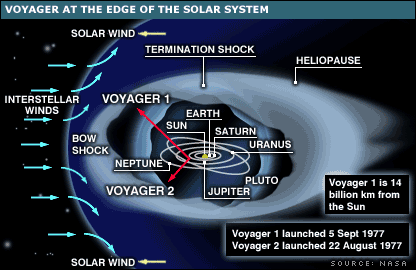Voyager 1 is the most distant man-made object

The Voyager 1 spacecraft is approaching the edge of the solar system. The spacecraft that was launched in 1977 is now 14 billion kilometers from the Sun, on the edge of deep space. NASA scientists said at a news conference in New Orleans on Thursday that the spacecraft is moving through a region known as the heliosheath.
This is a vast area where the influence of the sun ends and the particles fired from its surface crash and turn into thin clouds of gas moving between the stars. Soon, although researchers are not sure when, the spacecraft will cross this boundary into deep space.
"Voyager 1 has now entered the final envelope of its journey to the edge of interstellar space." said Dr. Edward Stone, director of the Voyager project at the California Institute of Technology in Pasadena.
Last November, scientists debated whether Voyager had already reached the so-called termination shock region. This is where the "wind" of charged particles coming from the sun is slowed down by the counter pressure of the interstellar gas. In the shock region, the solar wind particles slow down from a speed of 1.1-2.4 million km/h and become denser and hotter. Some researchers believe that the spacecraft has already reached the shock zone, others believe that it still has some distance to go.
Now, at the joint meeting of the American Gyrophysical Society for 2005, the confidence of the scientists increased that Voyager has already passed the shock zone and is already floating in deep space.
Predicting the location of the termination shock was difficult, the researchers say, because the exact conditions of interstellar space are unknown.
In addition, changes in the speed and pressure of the solar wind cause the shock zone to expand, melt and raise waves.
The most convincing evidence that Voyager 1 has passed the shock wave is its measurements, according to which it revealed a sudden increase in the strength of the magnetic fields carried by the wind, together with an increase in its velocity disturbances. This happened every time the solar wind slowed down.
The initial mission length of Voyager 1 was five years but it was extended due to the good performance of the spacecraft. The spaceship also carries with it a time capsule in the form of a golden record, together with a needle and instruments for hearing it, which includes recordings of greetings from the Earth in various languages as well as samples of music ranging from Mozart to the blind singer Willie Johnson.
The twin spacecraft, Voyager 2 which was launched a few weeks before Voyager 1, is moving in a different direction and is 10.4 billion kilometers from the Sun.
